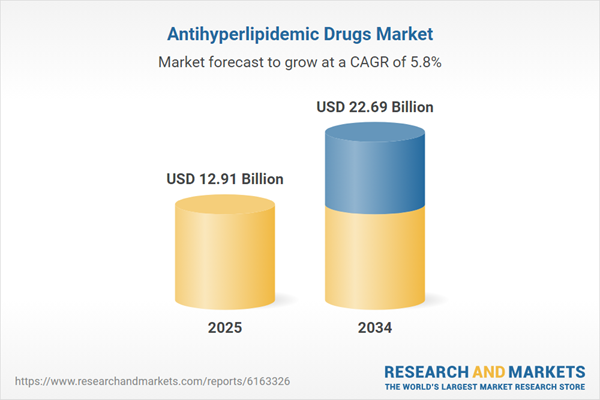Antihyperlipidemic Drugs: Introduction
Antihyperlipidemic drugs, also known as hypolipidemic drugs, are agents used to lower the lipoprotein (fats, cholesterol, triglyceride) levels in the blood. Cholesterol is a fat-like, waxy substance present in the blood. It is crucial to the healthy functioning of the body as it is used in building healthy cells, vitamins, and other hormones. However, too much cholesterol gets accumulated on the blood vessels and can lead to serious cardiac issues, including heart failure and stroke.Lifestyle changes like a healthier diet, regular exercise, minimal consumption of alcohol can prevent or treat unhealthy cholesterol levels for some people. However, people with severely high cholesterol levels need antihyperlipidemic drugs for treatment.
Global Antihyperlipidemic Drugs Market Analysis
Hyperlipidaemia is a critical medical condition, arising due to abnormally high levels of cholesterol in the body. Around 24% of the cardiovascular diseases are attributable to high LDL cholesterol in the body. It occurs due to accumulation of atherosclerotic plaque resulting in insufficient blood flow to important body parts like brain, heart, and limbs. As a result, significant antihyperlipidemic drugs market growth can be anticipated in the coming years.Statins are the most preferred treatment alternative for lowering LDL (bad) cholesterol and triglycerides while increasing HDL (good) cholesterol in the body. However, it also poses a risk of symptoms like headaches, dizziness, or digestive issues. Although the side effects are commonly treated with the help of combination medicines, there has been significant research to come up with improved and side-effect free statins. For instance, atorvastatin nanocrystals have been developed to combat the issue of its poor gastric solubility and low absolute bioavailability. This indicates that we can expect a significant growth in antihyperlipidemic drugs market value with rising research and development in the field.
Medical researchers are adopting new technologies to develop potent and affordable antihyperlipidemic drugs, with an aim to curb the threat of chronic cardiovascular diseases majorly associated with cholesterol levels. Bempedoic acid works on the mechanism of cholesterol synthesis inhibition. Other emerging drugs are Evinacumab (based on the use of monoclonal antibodies), Inclisiran and Volanesorsen (based on antisense oligonucleotides mechanism). Such developments in the pharmaceutical industry will be a key factor for high market demand in the future.
Global Antihyperlipidemic Drugs Market Segmentation
The report titled “Antihyperlipidemic Drugs Market Report and Forecast 2025-2034” offers a detailed analysis of the market based on the following segments:Market Breakup by Drug Class
- Statins
- PCSK9 Inhibitors
- Bile Acid Sequestrants
- Cholesterol Absorption Inhibitors
- Fibric Acid Derivatives
- Combination
Market Breakup by Distribution Channel
- Hospitals Pharmacies
- Retail Pharmacies
- Drug Stores
- E-Commerce
Market Breakup by Region
- North America
- Europe
- Asia Pacific
- Latin America
- Middle East and Africa
Global Antihyperlipidemic Drugs Market Overview
Majority of the global antihyperlipidemic drugs market share has been owned by the North American region. This is due to the high number of cardiovascular diseases in the region. However, with a robust healthcare industry that holds a prominent infrastructure for diagnostics and increased awareness around cardiac health, the cases have decreased in the area. It has been observed that cardiovascular mortality rates have decreased in high-income western countries like north-western Europe, North America, and Australia, inverse to the rise in Asia.Nowadays, majority of the deaths attributable to high LDL cholesterol are recorded in east, southeast, and south Asia, which indicates that global market for antihyperlipidemic drugs will observe a surge in the territory. Asian countries are home world's maximum percentage of geriatric population. Hence, they are already prone to face a significant hike in the number of cardiac surgeries. Moreover, rising investments around developing a proficient pharmaceutical and healthcare industry by the governments will fuel market growth.
Global Antihyperlipidemic Drugs Market: Competitor Landscape
The key features of the market report include patent analysis, grants analysis, clinical trials analysis, funding and investment analysis, partnerships, and collaborations analysis by the leading key players. The major companies in the market are as follows:- Bristol-Myers Squibb Company
- Merck & Co.
- AstraZeneca
- Mylan N.V
- Abbott
- Aparito Ltd.
- Amgen Inc.
- Daiichi Sankyo Company
- Pfizer Inc.
- Dr. Reddy's Laboratories Ltd
This product will be delivered within 3-5 business days.
Table of Contents
Companies Mentioned
- Bristol-Myers Squibb Company
- Merck & Co.
- AstraZeneca
- Mylan N.V
- Abbott
- Aparito Ltd.
- Amgen Inc.
- Daiichi Sankyo Company
- Pfizer Inc.
- Dr. Reddy’s Laboratories Ltd
Table Information
| Report Attribute | Details |
|---|---|
| No. of Pages | 350 |
| Published | July 2025 |
| Forecast Period | 2025 - 2034 |
| Estimated Market Value ( USD | $ 12.91 Billion |
| Forecasted Market Value ( USD | $ 22.69 Billion |
| Compound Annual Growth Rate | 5.8% |
| Regions Covered | Global |
| No. of Companies Mentioned | 10 |









